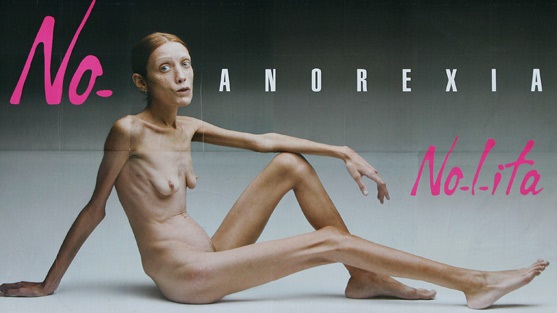(Warning: This article contains a NSFW image)
Paris is known for its fabulous haute couture, delicious croissants and the quintessential, enviably slim Parisian woman in her capsule wardrobe and stylish 'do. Not to mention the super-skinny fashion models that strut down the ramp at Paris Fashion Week.
Yet, the face (or should I say body?) of fashion might just be changing for the better - and soon.
According to France24.com, French Health Minister Marisol Touraine recently stressed the harmful use of super-skinny models on the catwalk and in fashion campaigns. She argues that accepting homogenised fashion bodies as an aesthetic ideal should become something of the past.
Amendments to a health bill will be discussed in French parliament, proposing a ban on the employment of super-skinny models and so-called “pro-ana” websites and forums that glamorise eating disorders and the super-skinny form.
If this bill passes, models would be required to undergo regular health checkups to ensure they’re not underweight. Those who employ models that are under a certain Body Mass Index (BMI) will be subject to a fine. According to Eatingdisorderhope.com, 1.0% to 4.2% of women will suffer from anorexia in their lifetime.
In 2007, French model, Isabelle Caro was photographed by Oliviero Toscani for an anti-anorexia billboard that made world headlines. She posed naked, showing her broken down and emaciated body to warn others against destructive eating disorders. Even though this certainly created a lot of controversy in the fashion world, not much changed in terms of actual model regulations.

Image source: Facebook
Ever since Kate Moss popularised heroin chic in the mid-nineties, designers and editors have clung to the idea of the super (almost scarily) thin, instead of the healthy and athletic.
In 2006, British writer Imogen Edwards-Jones wrote Fashion Babylon, which told of models’ excessive laxative use to maintain their size 0 figures. To add to this, ex Vogue Australia editor, Kirstie Clements published a tell-all tale in 2013, The Vogue Factor, about the cut-throat industry that is fashion. She shared stories of model behaviours and how the super-skinny stayed that way. She listed eating tissues to stay full (much like the cotton-ball diet, made famous last year), models struggling to keep themselves upright at shoots, because they were so weak; and models starving themselves to drop two dress sizes in order to get work.
Italy and Spain were some of the first countries to adopt rather progressive health initiatives as they’ve already banned catwalk models who fall below what they deem an unhealthy BMI; and Israel passed an anti-skinny-model law in 2011.
Last year, one small town in Argentina was hailed for becoming one of the first-ever places to put an actual full-on ban on beauty pageants, reported The Independent. Seeing them as sexist and harmful to women’s self-image, the Chivilcoy council, in the Buenos Aires region, said that beauty pageants only looked at outer beauty, which often brought on unhealthy relationships with food.
Many hoped a massive change would come in 2012, when 19 Vogue magazine editors from around the world, including those from France, Britain and China, publically vowed not to use under-aged models or girls who appear to suffer from an eating disorder. Unfortunately, this was more of a “hype over health stunt”, reports The Huffington Post.
These 19 Vogue editors who run the world’s so-called “Fashion Bible”, failed to address the way in which photos are digitally enhanced, which ultimately promotes impossible standard of beauty. Israel was one of the first countries to apply strict regulations when it comes to publicity photos and how they can be photoshopped – any changes to the model’s silhouette must be clearly noted on the photo.
Many say that fashion directors, editors, photographers and designers still prefer and even admire extremely thin models. And last year, British Vogue editor, Alexandra Shulman confirmed this to The Telegraph when she said that her readers don’t want to see themselves in the magazine, they want to escape, to dream and see images that they can aspire to. She did, however, say that she wished designers would cut bigger sample sizes and use bigger women in their campaigns and on runway. This, however, rarely (read: never) happens.
Punting images of beauty that are unhealthy and unattainable is institutional violence against women. In a world, so very obsessed with outer beauty, the regulation of the institutions which govern this world need to be policed harshly in order to secure the safety of its followers.
Serving up unrealistic (and often unhealthy) ideals of beauty reinforces the idea that women must be valued and rewarded exclusively on physical appearance alone. Our whole world then becomes that of a beauty pageant. Judged, stared at, told to perform: dance monkey, dance!
Follow Women24 on Twitter and like us on Facebook.




 Publications
Publications
 Partners
Partners










